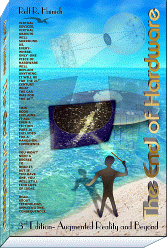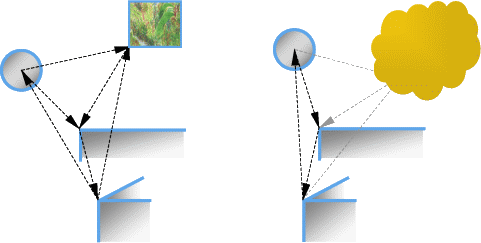
Augmented Reality is more than Virtual Reality
Orientation
Augmented reality glasses have to provide their own visual orientation, as it is the only means to keep up with our own. One could assume this to be very difficult, yet it is by no means as hard as the usual task of 'image recognition'. We don't need to actually recognize anything (e.g. find out its meaning and which details actually belong to a certain physical object).
It's entirely sufficient here to pick arbitrary primitive image details ('atoms'), normalize them in orientation and size and store their (short and simple) descriptions together with their relative distances. Such structures can later on be compared to new impressions with very little computational effort.To the left, several primitives ('atoms') of a scene have been normalized in orientation and size and linked with pointers. To the right, although one of the primitives is occluded, the others together with their relating distances and orientation coefficients etc. (not shown) provide good confidence that we are indeed dealing with the same scene.
The method is perspective and distance indpendent due to the normalization of the 'atoms' and the use of their real distances, and it is inherently rotation independent because we only use distance values and not vectors for comparison of the structure as a whole.
This appears to be very similar to the human method of orientation: we can remember locations by just seeing a little detail of a scene, while usually we also only remember a limited amount of detail at all.
After recognizing a certain scene, the system can derive its own actual position from the relative real distances, sizes and orientation of the details involved.
home more notes order
Copyright © 2006-2011 Rolf R. Hainich; all materials on this website are copyrighted.
Disclaimer: All proprietary names and product names mentioned are trademarks or registered trademarks of their respective owners. We do not imply that any of the technologies or ideas described or mentioned herein are free of patent or other rights of ourselves or others. We do also not take any responsibility or guarantee for the correctness or legal status of any information in this book or this website or any documents or links mentioned herein and do not encourage or recommend any use of it. You may use the information presented herein at your own risk and responsibility only. To the best of our knowledge and belief no trademark or copyright infringement exists in these materials. In the fiction part of the book, the sketches, and anything printed in special typefaces, names, companies, cities, and countries are used fictitiously for the purpose of illustrating examples, and any resemblance to actual persons, living or dead, organizations, business establishments, events, or locales is entirely coincidental. If you have any questions or objections, please contact us immediately. "We" in all above terms comprises the publisher as well as the author. If you intend to use any of the ideas mentioned in the book or this website, please do your own research and patent research and contact the author.
